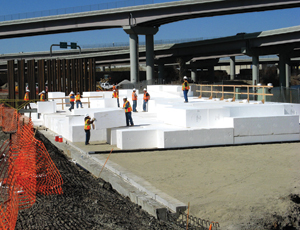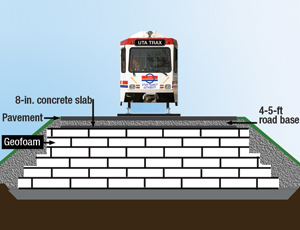In the second-largest application ever of its kind, hundreds of truckloads of polystyrene block are helping expedite an expansion of Salt Lake City’s Transit Express (TRAX) light-rail system. The lightweight material, akin to styrofoam, is helping Utah Transit Authority save at least $20 million and eight months of time by avoiding soil settlement issues.


The $370-million, four-station project extends the existing 19-mile, 28-station dual-line system five miles. A joint venture of Stacy and Witbeck Inc., Alameda, Calif., and Kiewit Western Co., Littleton, Colo., holds a $160-million contract and broke ground in June 2008, with anticipated completion in June 2010. The team has earned half of $3 million in potential incentives.
Designed by Wilbur Smith & Associates, Columbia, S.C., the route alignment crosses under Interstate 15 and has four flyovers, including a 780-ft-long bridge at the Union Pacific Railroad’s Roper Yard. Engineered by Ralph L. Wadsworth, Draper, Utah, the three-span steel-girder and concrete deck structure has a 24-ft-high, 330-ft-long main span.
Roughly 405,000 cu ft of Geofoam, an expanded polystyrene product produced by Denver-based ACH Foam Technologies, will be used as base embankment fill around the bridge and at seven other flyover locations. ACH claims it is the second-largest Geofoam installation, trailing Salt Lake City’s $1.3-billion, 17-mile I-15 widening, which used 3,531,460 cu ft.
“It will take 620 truckloads to deliver all the Geofoam needed for this project,” says ACH sales representative Terry Meier. The product has been available for 25 years, but its environmentally friendly qualities are spurring renewed interest, he adds.
The alignment crosses a former lake bed with collapsible, claylike soil, which officials anticipate could cause up to 10% settlement within three years. “The Geofoam allows us to build the project much faster and avoid settlement issues,” says UTA project manager Jim Webb. He estimates the product will save at least $20 million in price-escalation delays. Traditional solutions such as excavating and importing fill proved more costly and time-consuming.
“Geofoam looks and works like Styrofoam,” says UTA spokesman Gerry Carpenter. “The ground is very marshy. It could be compacted and it would still continue to settle over the years. Geofoam doesn’t settle. Once you set it, it’s done.”
According to ACH, the material has up to 223-lb-per-sq-ft compressive strength. While soil can weigh up to 110 lb per cu ft, Geofoam weighs only up to 3 lb per cu ft.
The product is cut into giant Lego-like building blocks, each 3 ft thick, 12 ft long and 4 ft high and weighing between 165 lb to 194 lb. Blocks are stacked and arranged into a base up to 42 ft high for embankments. They are topped by layers of concrete or, for road base, aggregate and asphalt.
The new West Valley line is expected to attract 5,250 daily riders upon completion, reaching 10,000 riders by 2030. It is part of the $2.5-billion FrontLines 2015 Railway Lines program, funded by a ¼-cent sales tax referendum passed in November 2006. Plans call for 70 miles of light- and commuter-rail extensions, doubling the capacity and track mileage of the 10-year-old TRAX system in the greater Salt Lake City area.
Four of five new segments are under construction, but a dip in sales-tax revenue has UTA uncertain about future construction plans. “Cash flow is a concern with the recession,” says Carpenter.

Post a comment to this article
Report Abusive Comment